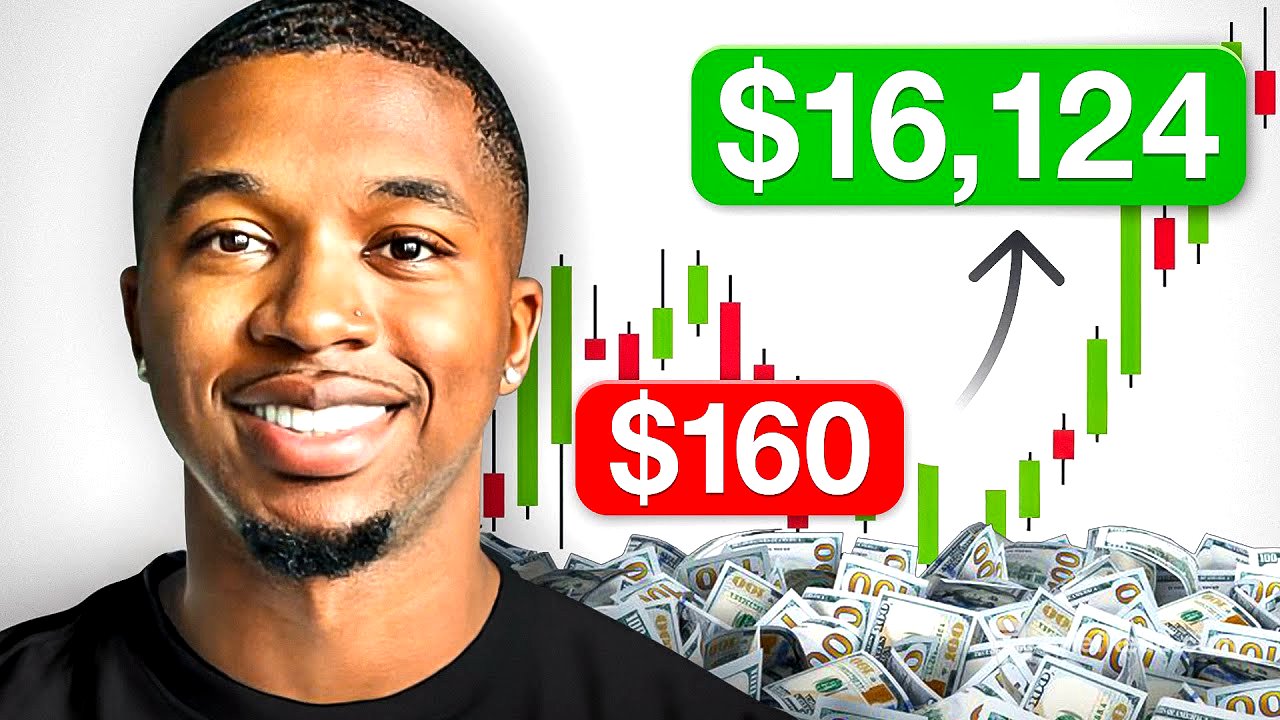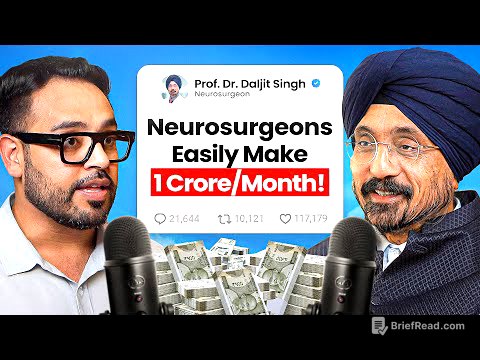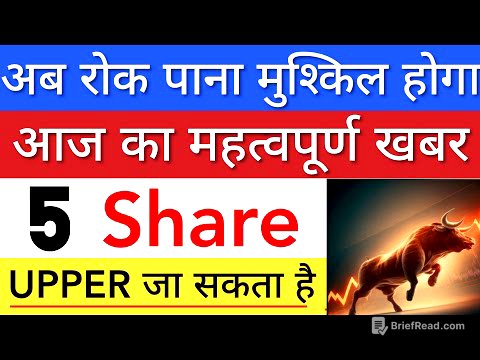TLDR;
This comprehensive 6-hour course provides a step-by-step guide to becoming a profitable day trader, covering essential aspects such as chart reading, candlestick analysis, platform selection, strategy mastery, trade management, and risk control. It addresses common day trading myths, compares different markets (Forex, Futures, Stocks, Crypto), and offers insights into technical and fundamental analysis, trading psychology, and funded accounts.
- Day trading involves predicting price movements in various markets.
- Key skills include chart analysis, risk management, and emotional discipline.
- Forex and Futures are highlighted, but principles apply broadly across markets.
- Trading psychology and funded accounts are crucial for long-term success.
Learn Day Trading for Beginners: Full Overview [0:00]
The video introduces day trading as predicting price movements of stocks, crypto, Forex, or futures based on patterns. It contrasts day trading with long-term stock holding, emphasizing short-term profits and risk management. Day trading allows profits in both rising (bull) and falling (bear) markets, offering more control over investments. The presenter, Joovier, shares his background and introduces the course's aim to simplify day trading, making it accessible even to beginners.
Day Trading Myths That Are Holding You Back [6:59]
The video addresses common myths about day trading, clarifying that it is a legitimate way to make money, doesn't require vast amounts of capital to start, doesn't demand hours of daily commitment, and doesn't necessitate years of learning before seeing profits. It also debunks the idea that expensive equipment is essential, highlighting that trading can be done from a phone or basic computer.
Forex vs Futures vs Stocks vs Crypto: Which Should You Trade? [7:33]
The video outlines the five major markets for day trading: Forex, Futures, Stocks, Options, and Crypto. Forex involves trading currency pairs, while futures trading deals with contracts for commodities, indices, or energies. Options trading is similar to futures but involves trading stocks and indices with leverage. Crypto trading involves speculating on the price movements of cryptocurrencies like Bitcoin and Ethereum. The course focuses primarily on Forex and Futures due to the presenter's expertise, while noting that 90% of the information applies across all markets.
Forex vs Futures Trading: Key Differences Explained [10:19]
The video provides a simple comparison of Forex and Futures trading, outlining the pros and cons of each to help traders make informed decisions. Forex, or foreign exchange, involves trading currencies and is the largest, most liquid market, operating 24/5. Futures trading involves contracts for future buying or selling of commodities like gold or oil at a set price.
Forex Trading Pros and Cons for Small Accounts [12:00]
The video details the advantages and disadvantages of Forex trading, particularly for those with smaller accounts. Forex is open 24/5 and is highly liquid, making it accessible for trading with small amounts of capital. However, it can be very volatile, and less regulated in some countries, and brokers may have hidden fees.
Futures Trading Pros and Cons: Fast Profits, Low Spreads [13:28]
The video outlines the pros and cons of futures trading. Futures trading is highly regulated, offers clear pricing and low fees, and is suitable for fast trades using technical strategies. However, not all futures markets are open 24/7, and high leverage can make it risky, requiring initial knowledge to manage effectively.
How to Choose the Right Market for Your Trading Style [14:48]
The video discusses how to choose between Forex and Futures based on trading preferences. Forex is recommended for those who prefer trading currencies and want more flexible trading times. Futures are better for those who prefer structured charts, clean setups, and low spreads. The presenter expresses a personal preference for futures due to these factors.
Top Forex & Futures Pairs Every Trader Should Know [16:01]
The video identifies the top Forex and Futures pairs that traders should be aware of. The top five Forex pairs are EUR/USD, USD/JPY, GBP/USD, USD/CHF, and AUD/USD. The most popular futures contracts include ES (S&P 500 futures), NQ (NASDAQ futures), CL (crude oil), GC (gold), and ZB (30-year bonds). The presenter notes that the information in the video can be applied to any instrument, regardless of whether it's on the list.
Technical vs Fundamental Analysis: What’s Better for Trading? [20:16]
The video introduces market analysis, emphasizing its importance for predicting price movements. It describes two main types of analysis: fundamental and technical. Fundamental analysis involves looking at news and how it affects the markets, using tools to gauge the impact and timing of news events. Technical analysis uses charts and graphs to identify patterns and predict price movements based on previous market structure.
How to Trade News with ForexFactory (Step-by-Step) [23:40]
The video explains how to use ForexFactory.com for fundamental analysis, focusing on identifying when news events will occur, what they will affect, and how strong their impact will be. The presenter advises paying attention to red folder news events, particularly those related to USD, and avoiding trading 15 minutes before and after these events. The presenter also recommends being aware of world events that could affect the market.
How to Use TradingView: Complete Beginner's Guide [31:52]
The video provides a complete beginner's guide to using TradingView for technical analysis. It covers creating a free account, navigating the interface, and understanding key features such as symbol search, time frames, chart types, and indicators. The presenter explains how to use drawing tools to mark up charts and plan trades, and describes the various panels and scales for analyzing price and time.
How to Read Candlesticks Like a Pro Trader [43:00]
The video explains how to read candlesticks, which are visual representations of price movements on a chart. It describes the components of a candlestick, including the body and wicks, and explains how bullish (green) and bearish (red) candlesticks indicate price increases and decreases, respectively. The presenter details how to interpret the opening, closing, high, and low prices represented by the body and wicks of each candlestick.
Candlestick Patterns & Wicks Explained Simply [47:50]
The video continues the explanation of candlesticks, emphasizing the importance of wicks in understanding price action. Wicks indicate where the price traveled during a specific time frame, showing areas where the price was "scared of" or faced resistance. The presenter notes that analyzing candlestick patterns and wick formations can provide insights into potential future price movements.
Price Action Trading Basics: Structure, Trends, and Patterns [53:06]
The video introduces the basics of price action trading, emphasizing the importance of understanding patterns in the market. It explains that price never moves in a straight line but rather in a series of up and down movements, with retracements occurring in the opposite direction of the overall trend. The presenter notes that technical analysis helps traders understand when large financial institutions are likely to buy or sell, allowing them to "ride the wave" of the market.
Support and Resistance Strategy That Works [1:04:00]
The video details a support and resistance strategy, explaining how to identify areas where price has previously found support (bounced up) or resistance (sold off). The presenter describes how to draw support and resistance zones on a chart, using the wicks and bodies of candlesticks to define these areas. The presenter also explains the concept of "break and retest," where a broken support level becomes a resistance level, and vice versa. Trend lines are introduced as slanted support and resistance zones.
Heikin Ashi Candles: The Best Candlesticks to Use [1:17:35]
The video introduces Heikin Ashi candles as a tool for smoothing out price action and making charts easier to read. It explains how Heikin Ashi candles differ from regular candlesticks, with the body of each candle starting in the middle of the previous candle. The presenter notes that Heikin Ashi candles can help traders identify the average price over a period and cut out noise, but it's important to master regular candlesticks first.
How to Trade Breakouts and Ranges the Right Way [2:03:53]
The video describes how to identify and trade candlestick patterns, focusing on four key patterns: shooting stars (or inverse hammers), hammers, doges, and bullish/bearish engulfing patterns. It explains how these patterns can signal potential reversals or continuations of price trends, and provides examples of how to spot them on a chart. The presenter notes that while these patterns can be used with regular candlesticks, doges are particularly effective with Heikin Ashi candles.
How to Use Indicators Without Getting Confused [2:06:29]
The video discusses the use of indicators in trading, describing them as "sidekicks" that can help simplify chart analysis. The presenter cautions against using too many indicators, as this can lead to confusion. The presenter recommends Killzones, VWAP (Volume Weighted Average Price), and Moving Averages as useful indicators, particularly for beginner traders.
Best Indicators for Day Trading: Moving Averages & Volume [2:18:40]
The video details how to use the Killzones indicator to visualize trading sessions and the VWAP indicator to identify the overall trend. It explains how the Killzones indicator highlights the New York, London, and Tokyo sessions, while the VWAP shows the average price based on volume, helping traders determine whether to focus on buy or sell opportunities. The presenter also briefly mentions moving averages as another useful indicator.
My Top 3 Day Trading Strategies (Backtested) [3:15:41]
The video introduces three day trading strategies, emphasizing the importance of aligning the strategy with the trader's personality and risk tolerance. It describes scalping, intraday trading, and swing trading as different styles, each with its own time commitment and risk profile. The presenter then details three specific strategies: an ultimate support and resistance strategy, a squeeze strategy, and a scalping strategy.
How to Backtest a Trading Strategy on TradingView [3:35:03]
The video emphasizes the importance of back testing trading strategies to gain confidence and familiarity with the market. It explains how to use TradingView's replay feature to go back in time and simulate trading scenarios, and recommends using the Killzones indicator to focus on specific trading sessions. The presenter also provides a workaround for back testing with Heikin Ashi candles, which are not directly supported by TradingView's replay feature.
Build & Optimize Your Trading Strategy for Live Markets [3:36:16]
The video details how to track and optimize trading strategies through journaling. It outlines the key metrics to record for each trade, including the date, time, instrument, direction, position size, risk, expected profit, actual profit/loss, and reasons for entry and exit. The presenter emphasizes the importance of analyzing this data to identify patterns and improve decision-making.
Trading Psychology Masterclass: Mindset for Profits [4:05:00]
The video emphasizes the importance of psychology in trading, stating that it accounts for over 80% of success. It explains that while technical skills are relatively easy to learn, mastering emotions and impulses is the biggest challenge. The presenter outlines key principles for developing a strong trading psychology, including thinking in terms of probabilities, developing a carefree mindset, and creating a bulletproof trading plan.
What Are Funded Accounts? (How They Work) [5:19:25]
The video introduces prop firms as a way for traders to access capital without risking their own money. It explains that traders pay a fee to take a challenge, and if they pass the challenge, they are given access to a funded account and can keep a percentage of the profits they generate. The presenter highlights the benefits of prop firms, including access to capital, forced risk management, and limited downside.
Best Prop Firm to Use (No Challenges) [5:21:17]
The video promotes the presenter's own prop firm, The Edge Funder, as a superior option due to its direct funding model, which eliminates the need for a challenge. The presenter argues that this model is more beneficial to traders, allowing them to start making money immediately without having to pass an evaluation.
How to Trade Like a Funded Pro (Risk Control & A+ Setups) [5:36:00]
The video provides advice on how to trade like a funded professional, emphasizing the importance of risk control and only taking A+ setups. It recommends starting with a conservative risk approach, risking no more than 1% of the account per trade, and creating a separate trading plan specifically for the funded account.
How to Master Discipline and Emotions in Live Trading [5:40:00]
The video emphasizes the importance of discipline and emotional control in live trading. It recommends creating mental rules to avoid trading when experiencing strong emotions, and suggests using Heikin Ashi candles to smooth out price action and reduce stress. The presenter also advises traders to trust their trades and walk away from the computer after entering a position.
How to Stay Consistently Profitable Long-Term [6:10:00]
The video outlines key principles for maintaining long-term profitability in day trading. It emphasizes the importance of emotional regulation, continuous learning, and sticking to a proven trading plan. The presenter stresses that successful trading is a marathon, not a sprint, and requires discipline and a long-term perspective.
Trade Live With Joovier in His Inner Circle (Invite Only) [6:20:00]
The video concludes by inviting viewers to apply to join the presenter's inner circle, a mentorship program that offers live trading sessions, one-on-one access to the presenter, and a community of profitable traders. The presenter emphasizes that the inner circle is designed for serious traders who are committed to achieving financial freedom.









